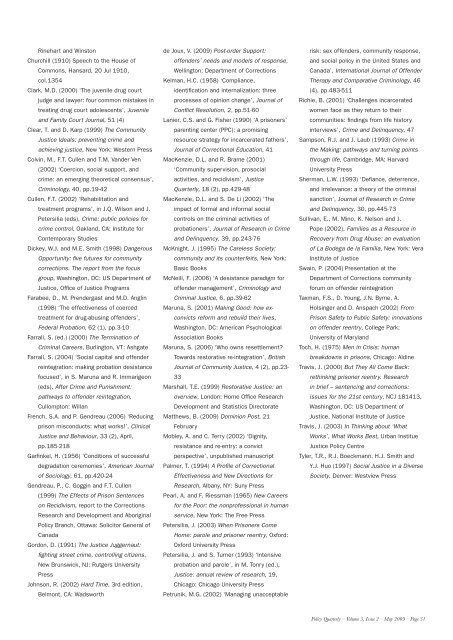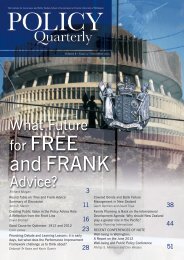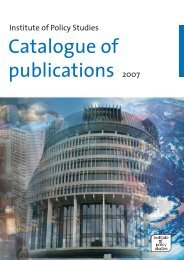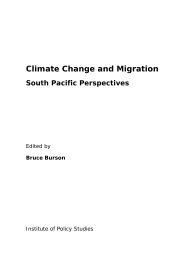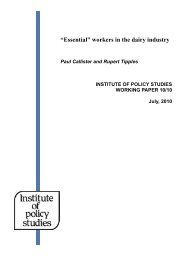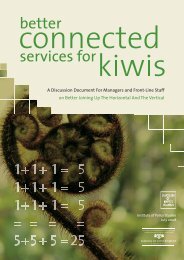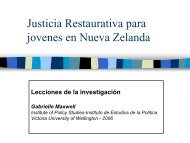Churchill - Institute for Governance and Policy Studies
Churchill - Institute for Governance and Policy Studies
Churchill - Institute for Governance and Policy Studies
- No tags were found...
Create successful ePaper yourself
Turn your PDF publications into a flip-book with our unique Google optimized e-Paper software.
Rinehart <strong>and</strong> Winston<strong>Churchill</strong> (1910) Speech to the House ofCommons, Hansard, 20 Jul 1910,col.1354Clark, M.D. (2000) ‘The juvenile drug courtjudge <strong>and</strong> lawyer: four common mistakes intreating drug court adolescents’, Juvenile<strong>and</strong> Family Court Journal, 51 (4)Clear, T. <strong>and</strong> D. Karp (1999) The CommunityJustice Ideals: preventing crime <strong>and</strong>achieving justice, New York: Western PressColvin, M., F.T. Cullen <strong>and</strong> T.M. V<strong>and</strong>er Ven(2002) ‘Coercion, social support, <strong>and</strong>crime: an emerging theoretical consensus’,Criminology, 40, pp.19-42Cullen, F.T. (2002) ‘Rehabilitation <strong>and</strong>treatment programs’, in J.Q. Wilson <strong>and</strong> J.Petersilia (eds), Crime: public policies <strong>for</strong>crime control, Oakl<strong>and</strong>, CA: <strong>Institute</strong> <strong>for</strong>Contemporary <strong>Studies</strong>Dickey, W.J. <strong>and</strong> M.E. Smith (1998) DangerousOpportunity: five futures <strong>for</strong> communitycorrections. The report from the focusgroup, Washington, DC: US Department ofJustice, Office of Justice ProgramsFarabee, D., M. Prendergast <strong>and</strong> M.D. Anglin(1998) ‘The effectiveness of coercedtreatment <strong>for</strong> drug-abusing offenders’,Federal Probation, 62 (1), pp.3-10Farrall, S. (ed.) (2000) The Termination ofCriminal Careers, Burlington, VT: AshgateFarrall, S. (2004) ‘Social capital <strong>and</strong> offenderreintegration: making probation desistancefocused’, in S. Maruna <strong>and</strong> R. Immarigeon(eds), After Crime <strong>and</strong> Punishment:pathways to offender reintegration,Cullompton: WillanFrench, S.A. <strong>and</strong> P. Gendreau (2006) ‘Reducingprison misconducts: what works!’, ClinicalJustice <strong>and</strong> Behaviour, 33 (2), April,pp.185-218Garfinkel, H. (1956) ‘Conditions of successfuldegradation ceremonies’, American Journalof Sociology, 61, pp.420-24Gendreau, P., C. Goggin <strong>and</strong> F.T. Cullen(1999) The Effects of Prison Sentenceson Recidivism, report to the CorrectionsResearch <strong>and</strong> Development <strong>and</strong> Aboriginal<strong>Policy</strong> Branch, Ottawa: Solicitor General ofCanadaGordon, D. (1991) The Justice Juggernaut:fighting street crime, controlling citizens,New Brunswick, NJ: Rutgers UniversityPressJohnson, R. (2002) Hard Time, 3rd edition,Belmont, CA: Wadsworthde Joux, V. (2009) Post-order Support:offenders’ needs <strong>and</strong> models of response,Wellington: Department of CorrectionsKelman, H.C. (1958) ‘Compliance,identification <strong>and</strong> internalization: threeprocesses of opinion change’, Journal ofConflict Resolution, 2, pp.51-60Lanier, C.S. <strong>and</strong> G. Fisher (1990) ‘A prisoners’parenting center (PPC): a promisingresource strategy <strong>for</strong> incarcerated fathers’,Journal of Correctional Education, 41MacKenzie, D.L. <strong>and</strong> R. Brame (2001)‘Community supervision, prosocialactivities, <strong>and</strong> recidivism’, JusticeQuarterly, 18 (2), pp.429-48MacKenzie, D.L. <strong>and</strong> S. De Li (2002) ‘Theimpact of <strong>for</strong>mal <strong>and</strong> in<strong>for</strong>mal socialcontrols on the criminal activities ofprobationers’, Journal of Research in Crime<strong>and</strong> Delinquency, 39, pp.243-76McKnight, J. (1995) The Careless Society:community <strong>and</strong> its counterfeits, New York:Basic BooksMcNeill, F. (2006) ‘A desistance paradigm <strong>for</strong>offender management’, Criminology <strong>and</strong>Criminal Justice, 6, pp.39-62Maruna, S. (2001) Making Good: how exconvictsre<strong>for</strong>m <strong>and</strong> rebuild their lives,Washington, DC: American PsychologicalAssociation BooksMaruna, S. (2006) ‘Who owns resettlement?Towards restorative re-integration’, BritishJournal of Community Justice, 4 (2), pp.23-33Marshall, T.E. (1999) Restorative Justice: anoverview, London: Home Office ResearchDevelopment <strong>and</strong> Statistics DirectorateMatthews, B. (2009) Dominion Post, 21FebruaryMobley, A. <strong>and</strong> C. Terry (2002) ‘Dignity,resistance <strong>and</strong> re-entry: a convictperspective’, unpublished manuscriptPalmer, T. (1994) A Profile of CorrectionalEffectiveness <strong>and</strong> New Directions <strong>for</strong>Research, Albany, NY: Suny PressPearl, A. <strong>and</strong> F. Riessman (1965) New Careers<strong>for</strong> the Poor: the nonprofessional in humanservice, New York: The Free PressPetersilia, J. (2003) When Prisoners ComeHome: parole <strong>and</strong> prisoner reentry, Ox<strong>for</strong>d:Ox<strong>for</strong>d University PressPetersilia, J. <strong>and</strong> S. Turner (1993) ‘Intensiveprobation <strong>and</strong> parole’, in M. Tonry (ed.),Justice: annual review of research, 19,Chicago: Chicago University PressPetrunik, M.G. (2002) ‘Managing unacceptablerisk: sex offenders, community response,<strong>and</strong> social policy in the United States <strong>and</strong>Canada’, International Journal of OffenderTherapy <strong>and</strong> Comparative Criminology, 46(4), pp.483-511Richie, B. (2001) ‘Challenges incarceratedwomen face as they return to theircommunities: findings from life historyinterviews’, Crime <strong>and</strong> Delinquency, 47Sampson, R.J. <strong>and</strong> J. Laub (1993) Crime inthe Making: pathways <strong>and</strong> turning pointsthrough life, Cambridge, MA: HarvardUniversity PressSherman, L.W. (1993) ‘Defiance, deterrence,<strong>and</strong> irrelevance: a theory of the criminalsanction’, Journal of Research in Crime<strong>and</strong> Delinquency, 30, pp.445-73Sullivan, E., M. Mino, K. Nelson <strong>and</strong> J.Pope (2002), Families as a Resource inRecovery from Drug Abuse: an evaluationof La Bodega de la Familia, New York: Vera<strong>Institute</strong> of JusticeSwain, P. (2004) Presentation at theDepartment of Corrections community<strong>for</strong>um on offender reintegrationTaxman, F.S., D. Young, J.N. Byrne, A.Holsinger <strong>and</strong> D. Anspach (2002) FromPrison Safety to Public Safety: innovationson offender reentry, College Park:University of Maryl<strong>and</strong>Toch, H. (1975) Men in Crisis: humanbreakdowns in prisons, Chicago: AldineTravis, J. (2000) But They All Come Back:rethinking prisoner reentry. Researchin brief – sentencing <strong>and</strong> corrections:issues <strong>for</strong> the 21st century, NCJ 181413,Washington, DC: US Department ofJustice, National <strong>Institute</strong> of JusticeTravis, J. (2003) In Thinking about ‘WhatWorks’, What Works Best, Urban InstitueJustice <strong>Policy</strong> CentreTyler, T.R., R.J. Boeckmann, H.J. Smith <strong>and</strong>Y.J. Huo (1997) Social Justice in a DiverseSociety, Denver: Westview Press<strong>Policy</strong> Quarterly – Volume 5, Issue 2 – May 2009 – Page 31


